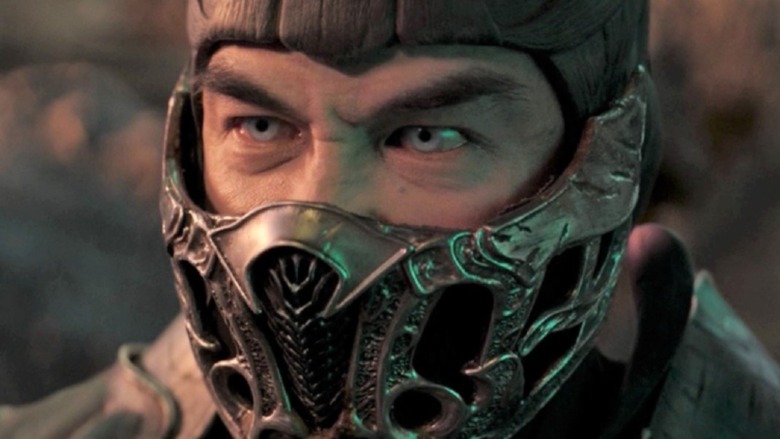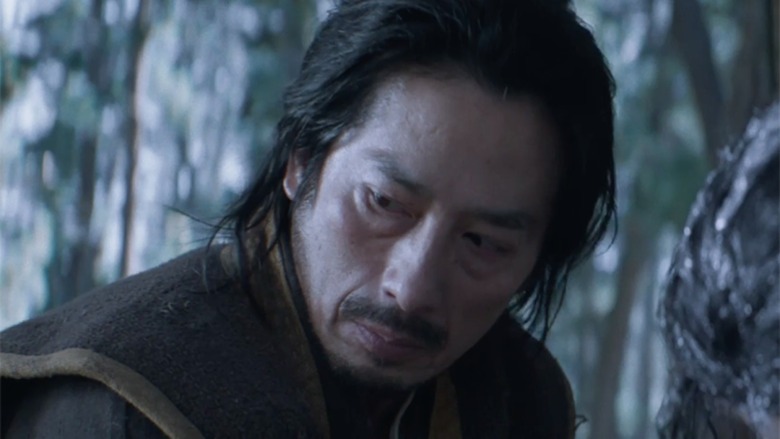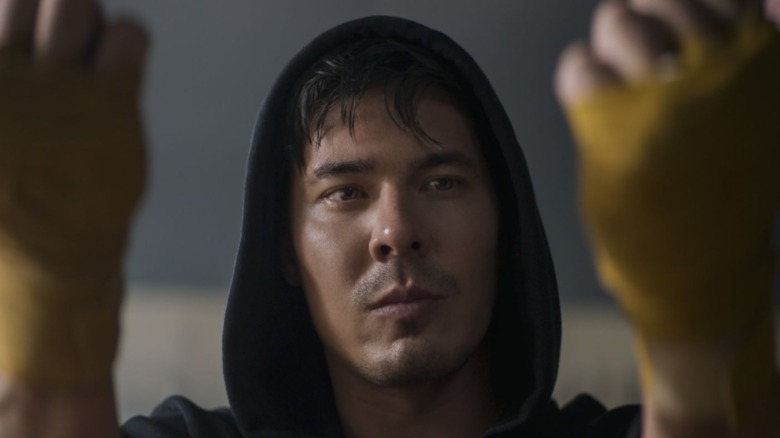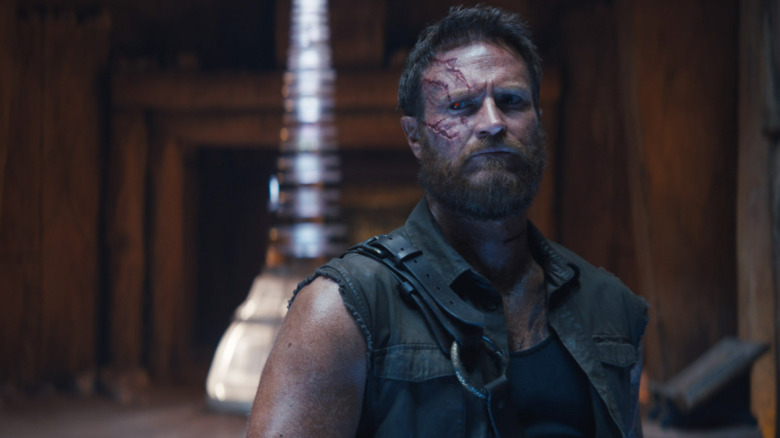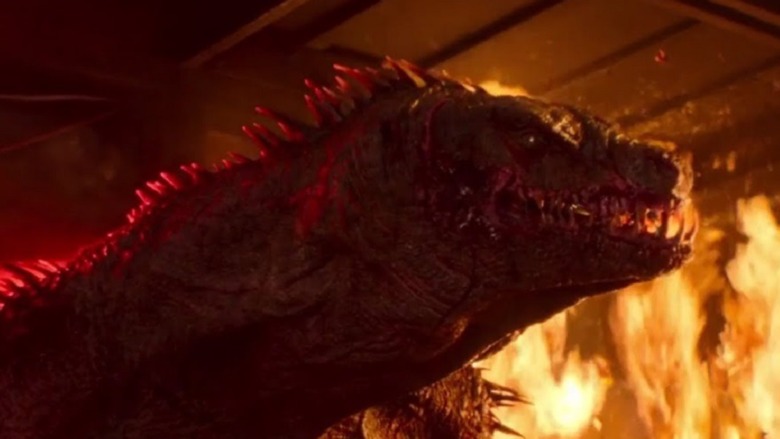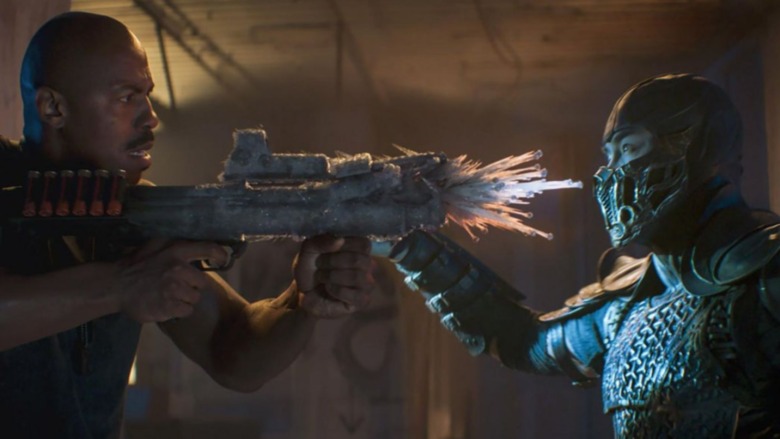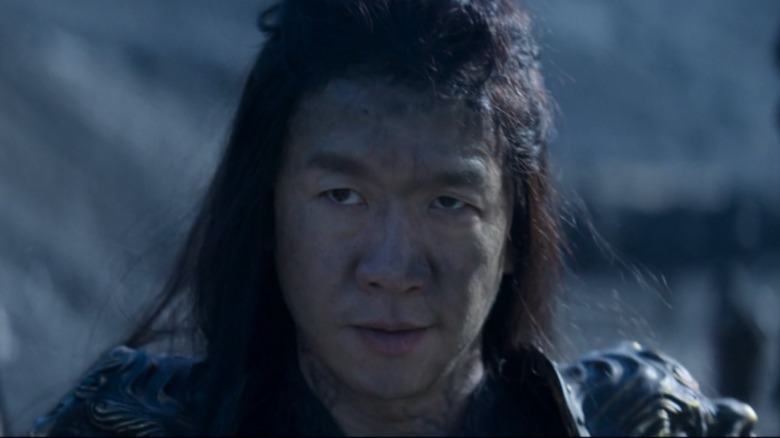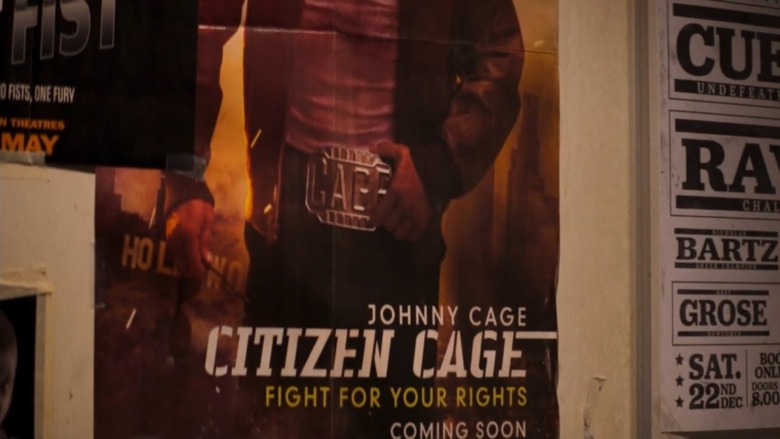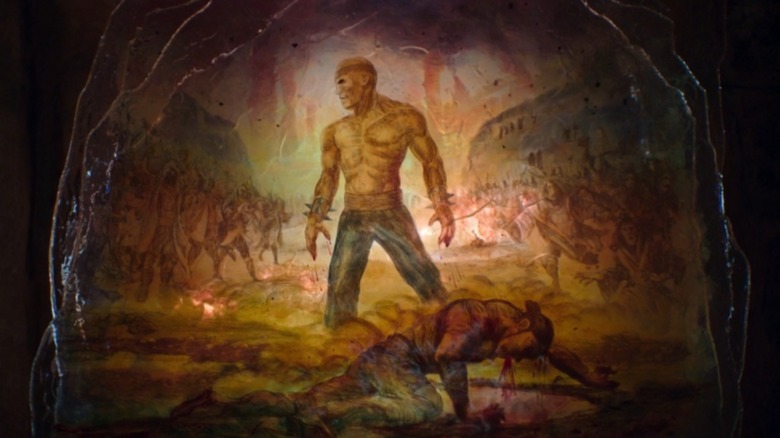Confusing Moments In Mortal Kombat Explained
The 1995 "Mortal Kombat" was a theatrical success, but the franchise's momentum would receive a devastating blow just two years later, as "Mortal Kombat: Annihilation" wiped plans for future films off the map. But after an extreme absence from the big screen, a new live-action reboot hit theaters and HBO Max in 2021.
Simply titled "Mortal Kombat," this video game adaptation killed during its opening weekend, earning $22.5 million during the COVID-19 pandemic, which is pretty impressive. And it deserves those box office accolades, as the film is a decent nod to the franchise, embraces its R rating, and is easier to follow than "Annihilation."
However, if you're not a die-hard Kombat fan, it can be a little hard to follow. It moves at a breakneck pace and features a shockingly large cast of supporting characters who are brought in to curse and eat fatalities. As a result, some moviegoers might feel a bit confused in between all those epic action scenes. But never fear, we're here to provide some answers. From ancient rivalries to mysterious characters, here are the most confusing "Mortal Kombat" moments explained.
Why do Scorpion and Sub-Zero hate each other so much?
Those with even a passing familiarity of the lore of "Mortal Kombat" know of the feud between Scorpion and Sub-Zero, arguably the two biggest characters in the franchise. And the movie kicks off with their rivalry on full display. On a calm, serene day, Bi-Han (Sub-Zero) shows up to annihilate Hanzo Hasashi's (Scorpion) entire clan, including his wife and son. This bloodbath sets the story in motion, but what started the conflict in the first place? Why do these guys hate each other so much?
Well, during their battle, Sub-Zero mentions his clan, the Lin Kuei, and Scorpion's, the Shirai Ryu. The film doesn't inform us why the two clans are rivals, but the games are much clearer about this. The Lin Kuei is a clan of ninja assassins from China who are often hired out as mercenary killers. A former member named Takeda stole secrets from the clan, escaped to Japan, and founded the Shirai Ryu, beginning the struggle between the two groups and unknowingly dooming his people. So while the movie doesn't really delve into this complicated backstory, the intense hatred between Scorpion and Sub-Zero makes a lot more sense once you realize all the ninja drama that's been going on behind the scenes.
How did Cole Young free Scorpion?
The 2021 film introduced a new kombatant to the franchise with MMA fighter Cole Young. The athlete isn't from the games in any form, but the filmmakers tied him into the universe by making Cole the descendant of one of the biggest characters on the roster, Scorpion. And before that big reveal, there are several clues to Cole being a distant relative of Hanzo Hasashi, like his hands being clad in the same shade of yellow as Scorpion's traditional costume.
About halfway through the film, Raiden drops the truth on Cole, and we learn that Hanzo's child (who the Thunder God rescued in the opening) went on to have children, leading to the eventual birth of Cole. This makes him a direct member of Hanzo's bloodline, a recipient of the family's dragon marking, and someone chosen to participate in Mortal Kombat. However, as it turns out, Cole's heritage has an extra benefit — the ability to summon Scorpion.
When the final battle with Sub-Zero begins, Cole uses Hanzo's kunai — that iconic dart-like weapon — to call forth the vengeful wraith, making it a two-on-one showdown. But how exactly does that work? While there could be some deeper connection to Hanzo, with his family once again in danger, it seems the answer is a bloody one. See, Hanzo's weapon is stained with his own blood, and when Cole grabs the blade, it cuts his own palm. His blood mingles with Hanzo's, unleashing Scorpion's spirit from Hell. And after Hanzo takes his revenge, the yellow-clad ninja tells Cole that he "freed" him, implying that there needed to be some type of trigger or sacrifice, like the blood, thus making Cole the conduit for Scorpion.
What's the history with Kano and Kabal?
Trevor Goddard's performance as Kano in the 1995 film changed the character, making any new depiction of him on the big screen a challenge. However, the charismatic Josh Lawson has risen to the challenge, turning up the comedic commentary, making several pop culture references, and literally responding to someone with "womp, womp" at one point. Sure, his story arc is pretty easy to predict for fans, but there is one plot point that might leave audiences confused. What's the deal between Kano and Kabal?
One of the first things we learn from Kabal is that Kano is the one responsible for putting him in the respirator. This differs from the games, where various timelines see Kabal either horribly scarred at the hands of Shao Kahn's extermination squads or majorly messed up by the multi-armed Kintaro. However, in the world of the film, Kano is the one who destroyed his life ... but why? Well, in the games, Kano is the leader of a mercenary group called the Black Dragon (their symbol shows up on his knife in the film), and in a newer timeline, Kabal is an undercover cop who infiltrates his gang. If this holds true for the films, that would definitely explain why Kano might want to scar the man.
Of course, it seems like this would've come up in conversation, so the simple answer looks to be the correct one. Following the original "Mortal Kombat" timeline, Kabal was another member of the Black Dragon, and after "Mortal Kombat 3," he had aspirations for taking over the group. So yeah, Kano couldn't have been too happy about that, prompting him to really ruin Kabal's day.
Why does Reptile look like that?
Reptile is a well-known character from the "Mortal Kombat" franchise, appearing as a secret opponent in the first game and as a playable character in the second. It was a great moment in the film to hear the character called by his Saurian name, Syzoth, but there was no mention of other members of his race (like Khameleon), which is a big part of his backstory. However, his appearance may also be a bit of a shock for casual fans of the games or those who've only seen the original movie. For many, Shang Tsung's servant was just another cool palette-swapped ninja sporting green ... so why does he look like a giant lizard in the 2021 film?
Well, members of Reptile's species are commonly called Raptors, and they're originally from Earthrealm. However, they fled due to a war between the gods. And in the game "Mortal Kombat 4," that's when the green ninja's look started to drastically change, and he began showing off his scales. This continued over some time, where the story had it that he was de-evolving — a side effect of not being near any of his fellow Saurians. And it's a change that not only affects his physical form but his thoughts too. In other words, Syzoth's bestial look makes sense with the games, especially "Mortal Kombat: Deadly Alliance."
But while the film has him in full-blown reptilian form, with no ninja aesthetic in sight, he does get to use many of his special moves from the games, like invisibility, acidic saliva, and his tongue attack. Sadly, he's taken out early on by Kano's classic fatality.
Why isn't Outworld waiting for the tournament?
One of the stranger things about 2021's "Mortal Kombat" is that we never actually see a tournament — you know, something "Mortal Kombat" is known for. Most fans were expecting to see the organized one-on-one battles, but the events of this film act as a prequel to that larger spectacle and confrontation. Raiden's crew are simply trying to train and stay alive until the official showdown happens. But if even Raiden won't interfere to save his own fighters before the tournament, then why is the villainous Shang Tsung so willing to risk the anger of the Elder Gods by wiping out the competition before Mortal Kombat actually begins?
Well, Shang Tsung hails from Outworld, a realm that's absorbed many other places and grows stronger with each. And Outworld has won nine Mortal Kombat tournaments against Earthrealm, and if they're victorious in one more, they'll get to run the place. If Earthrealm were to fall, not only would many people die, but there would be very little to stop Outworld from absorbing all the realms and potentially creating a much bigger problem. So yeah, Shang Tsung is pretty motivated to get rid of his Earthrealm rivals.
Plus, it would make sense if he were cheating under orders of his boss, Shao Kahn, who we see in the mural at Raiden's temple. As it turns out, Tsung was originally from Earthrealm, but he betrayed his home and bound his soul to Kahn's in exchange for more powers. So with his boss breathing down his neck and victory so close, he has a lot invested in succeeding at any cost.
Who are the Elder Gods?
Shang Tsung will do whatever it takes to win, even bending or breaking the rules as much as he can. But when one of his lackies worries that divine powers might get involved if Shang Tsung cheats, he says to leave the Elder Gods to him, knowing full well he has a lot of leeway in his actions. But who exactly are these Elder Gods? They aren't given much more of a mention in the film, but they are important, even if unseen. Raiden and his fighters even escape to the Void at one point — the in-between space that separates the realms and the heavens, where the gods live. In fact, the Elder Gods are above normal deities like Raiden, choosing to interact with folks through their underlings ... if at all. At one point, Shang Tsung even mentions that many of the Elder Gods are lazy, and there's a reason for his claim.
The Elder Gods act as judges for the universe, setting the rules of Mortal Kombat and how realms may interact with each other, but they're rarely the ones to enforce them. They hold immense power over the elements, life, and death, but the degrees of how strong they are compared to others isn't clear. They claim to be benevolent lords who try and maintain a balance between the realms, but they're often cruel and fail at overseeing these edicts until someone completely disregards the rules on a massive scale or they're threatened with a greater evil. Even then, they often don't interfere directly, usually imbuing others with the power to do so, as seen in the ending of "Mortal Kombat 9." In other words, the Elder Gods are very removed from everything happening below, allowing Shang Tsung to get away with a whole lot of rule-breaking.
Who exactly is Johnny Cage?
"Mortal Kombat" 2021 sends fans of the games home happy as Cole mentions he's going to Hollywood with the intent of recruiting someone new to help defend Earthrealm. The poster on the locker room wall tells us that it's Johnny Cage, a presence missed by many. For viewers that only have this movie to go off of, the last-minute namedrop may not seem like much, but he's kind of a big deal (at least, he'd say so). In some ways, Johnny Cage is the heart and soul of "Mortal Kombat," the comedic relief, and the character that fans could most easily relate to.
Not only was he the first fighter completed for the games, Cage has some of the best character development across the whole franchise. The struggling film star didn't originally join the tournament to save Earthrealm but to prove his martial arts skills and impress the critics back home, with the hopes of breathing new life into his career. Though he comes across as annoying and egotistical, Cage is a brave fighter who's true to his friends and has already died once in the line of duty trying to protect Earth. He even lost his wife in battle. Character-wise, there's a lot to work with here, and no one should be shocked if the actor and defender of the realm steals the spotlight in the sequel.
What's the meaning of the murals?
Raiden's temple holds many treasures and secrets. For example, we get a clear shot of Kitana's fan weapon, and it looks as if Kano attempts to steal Shinnok's amulet. But the real eye-catchers are a series of murals. Sonya Blade accurately describes them as "the living history of Mortal Kombat," but she doesn't go into most of the images or who the people depicted are. But from the paintings, it's clear that Cole Young and his companions aren't the first fighters to defend Earthrealm. After all, there's a lot of history between the two realms if Outworld has already won nine tournaments, but what do these paintings actually tell us?
The first mural we see shows the Great Kung Lao — whom the character with the bladed hat is named after — standing in triumph after winning the tournament nearly 500 years prior, stopping Outworld from absorbing the realm. The man Kung Lao is seen standing over is most likely Shang Tsung, who he defeated but spared. The third image, however, is his unfortunate loss to Prince Goro, 50 years later. Kung Lao's death set into motion Outworld's new series of victories against Earthrealm, leading up to the events of the first "Mortal Kombat" game.
As for the second mural, that's Argus, the god and protector of Edenia, and his wife, Delia, and the image most likely represents the eventual Armageddon, as seen in the "Mortal Kombat" game of the same name. And the fourth mural is a depiction of Shao Kahn, emperor of Outworld and the ultimate big bad. Both of these represent threats for the distant future, so perhaps these are clues for where the movies are headed.
